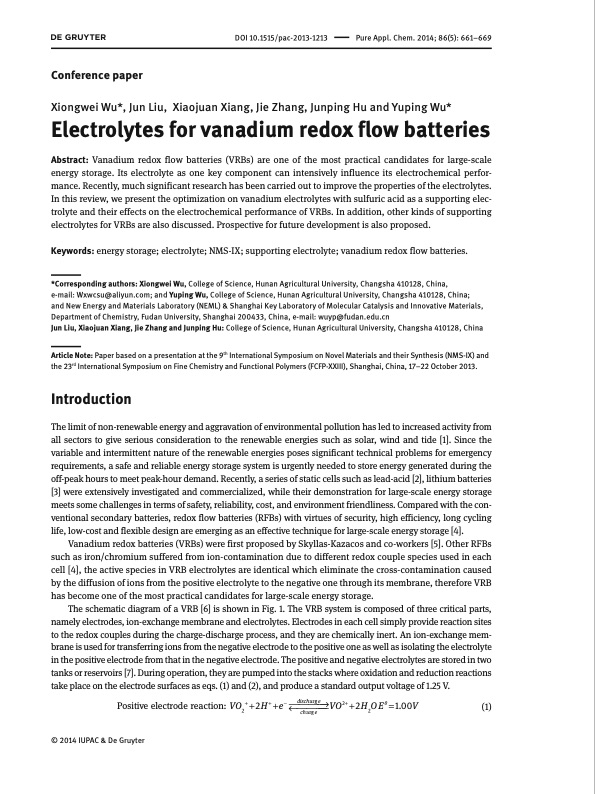
PDF Publication Title:
Text from PDF Page: 001
DOI 10.1515/pac-2013-1213 Pure Appl. Chem. 2014; 86(5): 661–669 Conference paper Xiongwei Wu*, Jun Liu, Xiaojuan Xiang, Jie Zhang, Junping Hu and Yuping Wu* Electrolytes for vanadium redox flow batteries Abstract: Vanadium redox flow batteries (VRBs) are one of the most practical candidates for large-scale energy storage. Its electrolyte as one key component can intensively influence its electrochemical perfor- mance. Recently, much significant research has been carried out to improve the properties of the electrolytes. In this review, we present the optimization on vanadium electrolytes with sulfuric acid as a supporting elec- trolyte and their effects on the electrochemical performance of VRBs. In addition, other kinds of supporting electrolytes for VRBs are also discussed. Prospective for future development is also proposed. Keywords: energy storage; electrolyte; NMS-IX; supporting electrolyte; vanadium redox flow batteries. *Corresponding authors: Xiongwei Wu, College of Science, Hunan Agricultural University, Changsha 410128, China, e-mail: Wxwcsu@aliyun.com; and Yuping Wu, College of Science, Hunan Agricultural University, Changsha 410128, China; and New Energy and Materials Laboratory (NEML) & Shanghai Key Laboratory of Molecular Catalysis and Innovative Materials, Department of Chemistry, Fudan University, Shanghai 200433, China, e-mail: wuyp@fudan.edu.cn Jun Liu, Xiaojuan Xiang, Jie Zhang and Junping Hu: College of Science, Hunan Agricultural University, Changsha 410128, China Article Note: Paper based on a presentation at the 9th International Symposium on Novel Materials and their Synthesis (NMS-IX) and the 23rd International Symposium on Fine Chemistry and Functional Polymers (FCFP-XXIII), Shanghai, China, 17–22 October 2013. Introduction The limit of non-renewable energy and aggravation of environmental pollution has led to increased activity from all sectors to give serious consideration to the renewable energies such as solar, wind and tide [1]. Since the variable and intermittent nature of the renewable energies poses significant technical problems for emergency requirements, a safe and reliable energy storage system is urgently needed to store energy generated during the off-peak hours to meet peak-hour demand. Recently, a series of static cells such as lead-acid [2], lithium batteries [3] were extensively investigated and commercialized, while their demonstration for large-scale energy storage meets some challenges in terms of safety, reliability, cost, and environment friendliness. Compared with the con- ventional secondary batteries, redox flow batteries (RFBs) with virtues of security, high efficiency, long cycling life, low-cost and flexible design are emerging as an effective technique for large-scale energy storage [4]. Vanadium redox batteries (VRBs) were first proposed by Skyllas-Kazacos and co-workers [5]. Other RFBs such as iron/chromium suffered from ion-contamination due to different redox couple species used in each cell [4], the active species in VRB electrolytes are identical which eliminate the cross-contamination caused by the diffusion of ions from the positive electrolyte to the negative one through its membrane, therefore VRB has become one of the most practical candidates for large-scale energy storage. The schematic diagram of a VRB [6] is shown in Fig. 1. The VRB system is composed of three critical parts, namely electrodes, ion-exchange membrane and electrolytes. Electrodes in each cell simply provide reaction sites to the redox couples during the charge-discharge process, and they are chemically inert. An ion-exchange mem- brane is used for transferring ions from the negative electrode to the positive one as well as isolating the electrolyte in the positive electrode from that in the negative electrode. The positive and negative electrolytes are stored in two tanks or reservoirs [7]. During operation, they are pumped into the stacks where oxidation and reduction reactions take place on the electrode surfaces as eqs. (1) and (2), and produce a standard output voltage of 1.25 V. charge © 2014 IUPAC & De Gruyter discharge Positive electrode reaction: VO + +2H+ +e− →VO2+ +2H OEθ =1.00V (1) 2 ← 2PDF Image | Electrolytes for vanadium redox flow batteries

PDF Search Title:
Electrolytes for vanadium redox flow batteriesOriginal File Name Searched:
10-1515_pac-2013-1213.pdfDIY PDF Search: Google It | Yahoo | Bing
Salgenx Redox Flow Battery Technology: Salt water flow battery technology with low cost and great energy density that can be used for power storage and thermal storage. Let us de-risk your production using our license. Our aqueous flow battery is less cost than Tesla Megapack and available faster. Redox flow battery. No membrane needed like with Vanadium, or Bromine. Salgenx flow battery
| CONTACT TEL: 608-238-6001 Email: greg@salgenx.com | RSS | AMP |